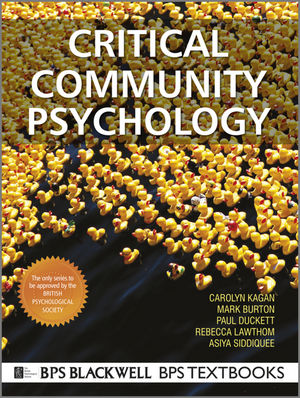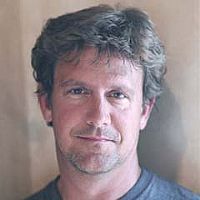

Title: Critical Community Psychology
autores
: Carolyn Kagan, Mark Burton, Paul Duckett, Rebecca Lawthom, Asiya Siddiquee
Reviewed by Scot D Evans, PhD
Kagan, C., Burton, M., Duckett, P., Lawthom, R., & Siddiquee, A. (2011). Critical Community Psychology (1st ed.). West Sussex, UK: Wiley-Blackwell.
The Society for Community Research and Action has recently been trying to develop a shared understanding of the desired competencies for students trained in our field. What should our students be able to do once they complete graduate training in CP? What is our “Community Psychology Value Proposition” (Elias, 2009) to the world (mainly potential employers) and what are the competencies they can expect a community psychologist to be adequately prepared to offer? The recent draft of the “Evidence-Based Community Psychology Value Proposition For Non-Academic Employers” (Ratcliff, 2011) includes a list of the potential capabilities of new and experienced community psychology practitioners. I have to say, that looking at this list makes me yearn for more and louder voices from the critical edge of community psychology. The discipline of community psychology desperately needs something to balance the dominance of technical-rational-pragmatic discourse and framing of our potential contribution. Many of us believe community psychology at its core is a critical social science when the espoused values, empowering processes, and desired ends are upheld. However, community psychology as we know it today is still too closely tied to psychology and its uncritical ways. Community psychology will never have an impact on the social justice issues facing marginalized communities simply by producing practitioners who apply community psychological techniques and skills to complex problems. We need thinkers and actors who are grounded in critical social theory and are able work alongside community groups to problematize existing power relations and push for social change.
Critical Community Psychology
Enter the much-needed Critical Community Psychology text by Carolyn Kagan and her colleagues at Manchester Metropolitan. Carolyn Kagan has long been a critical voice in our field. A SCRA Fellow since 2005, Kagan has, for over 30 years, been actively engaged with participatory community projects with disabled people, their families and services, and with people living in poverty. In her own writings and in many works co-authored with Mark Burton, Kagan has offered critical perspectives on community theory and practice that help bring awareness to the political nature of psychology and link and create dialogue across liberation psychology and critical, community and applied social psychology.
In the introduction to the book, the authors attempt to make clear what they mean by “critical”. Grounding the use of the term in critical theory, the authors suggest that being critical “is an approach that tries to understand a social reality through introduction of another, more penetrating frame of reference” (p.12). This description might puzzle some students and leave seasoned critical community psychologists wanting more. I for one would have liked to see a bit more fleshing out of the theoretical underpinnings of critical community psychology as a critical social science, but they prefer to let the substance of the book do the explicating. They do make the concept of being critical come to life for students a bit more in one of their first “Reflect” sidebars. The authors use these sidebars as pedagogical features in the book to challenge readers to pause and take stock of what they just read. They use a Reflect! sidebar in the introduction to give readers a series of questions they can use to check whether or not they are being critical.
About the book
The book is organized into three sections: Think! Act! Reflect! The Think! Section provides a useful overview of the history, definitions and conceptualizations of community psychology from different parts of the world and an introduction into the key themes in critical community psychology. There is a lot that is familiar to community psychologists here; however, there are some distinctive nuggets as well. For instance, the authors gently critique the usually sacred community psychology emphasis on prevention. Similar to how we critique treatment, they argue that experts often drive prevention efforts and “do not generally engage the potential victims in taking control of the circumstances that make them ill” (p. 29). The authors foreground a liberatory orientation that views victims and potential victims as agents, not just recipients of programs and services.
Kagan and company provide a set of core principles that differ from and expand the focus of the shared principles constructed by SCRA (http://www.scra27.org/about). They offer six principles for critical community psychology that include diversity, innovation, liberation, commitment, critical reflection, and humility. Notable here is the emphasis on relationship with and commitment to the community with which we work balanced with ongoing critical reflection, critical analysis and humility on the part of the community psychologist.
In this first section, Kagan and her colleagues also highlight the importance of connecting our community-based efforts to broader social movements. A critical community psychology embeds our local action in wider movements for social justice. They end this first section with a “Critical Disruption of “Think!”. Each of the three sections includes a “critical disruption” section at the end to encourage students to engage in the continual process of questioning and offering alternative ways of thinking. This first critical disruption includes a critique of our dominant construction of a history of community psychology that should be read and pondered by all community psychology students.
Part two of the book is the “Act!” section. In this section, the authors first present ways of understanding and defining a social problem or issue and then proceed to discuss ways of planning action. They present four key action strategies to promote change: furtherance of critical consciousness; creation of new social settings; development of alliances; and accompaniment, advocacy, and analysis of policy. While much of this section is pragmatic in its focus (e.g. stakeholder analysis, SWOT analysis, force field analysis) they give broad attention to the importance of strategies to promote critical consciousness and the development of alliances and counter-systems for action to spread change beyond the local issue and context.
One highlight of this section is the way that the authors discuss the process of building relationships with and gaining entry into community settings. They bring in the Latin American community psychology concept of incerción, which means, “becoming one of the community, living there and experiencing life alongside other community members” (p. 141). Working alongside community members and community partners in this manner implies working for them within longer-term commitments rather than one-off projects.
Another highlight of this section in the chapter on action planning is the discussion of “boundary critique”. As community psychologists, we are skilled at mapping the social issue or problem at hand as a system with defined boundaries. Boundary critique is the critically reflective process of “considering the different possible boundaries that might be used in analyses, and taking account of their possible consequences for intervention” (Midgley, et al, 1998, p. 467, as cited in Kagan, et al, 2011). How we draw boundaries around a project reflects underlying values and affects the nature of the project and range of impact. The authors offer a checklist of critical boundary questions (adapted form Ulrich, 2005) to assist in this boundary critique process.
Also in this section, the authors stress the importance of “walking alongside, listening to and witnessing the realities of the lives of people living in poverty” (p. 224) a process called accompaniment. Comas-Días et al (1998) define accompaniment as “standing alongside people, working with them, seeking to develop collaborative relations that recognize power inequities” (p. 779, as cited in Kagan, et al, 2011) in order to help people find ways of reclaiming their identities and representing their social realities.
Part three of the book is the Reflect! section. This section of the book discusses the importance of reflecting on and in action and community psychology practice. After a useful chapter on evaluation, the authors reflect on the nature of social change and the social structure of social power. They end the section by providing a thoughtful examination of the roles that community psychologists can play in facilitating social change and the skills needed to be effective at it. Here, critical reflexivity is highlighted as an essential component to critical psychology practice. While reflecting in and on action is crucial, reflexivity is a way of factoring oneself into the situation and considering how we affect and are affected by practice.
In the end, Kagan and her colleagues challenge us to consider whether our community psychology research and action is a resource for liberation or merely practice that helps disguise the oppression in the system. They point out that there has been little translation of critical theory into community psychology practice, and that is something that needs to change. I agree. For the authors, this is only likely if community psychologists are able to step outside the isolation and trappings of being psychologists.
Conclusion
This book in may ways echoes and amplifies the calls by others to envision and practice a “critical community psychology”; one that recognizes the limits of ameliorative community psychology (c.f. Kagan & Burton, 2001; Angelique, & Kyle, 2002; Angelique & Culley, 2007; Prilleltensky & Nelson, 2002; Fox, Prilleltensky, & Austin, 2009). With the depth of content, practical examples and unique pedagogical features, this book is a welcome addition to the somewhat limited array of community psychology textbooks available for our use. On page 242, the authors refer to Duckett’s (2009) observation that only a small percentage of academic texts are read and an even smaller percentage actually influence the academic field in any way. I, for one, hope this particular text makes it into our undergraduate and graduate classrooms so that community psychology training can be more critical and our community psychology graduates and field as a whole can be engaged in a critical praxis that has more potential to contribute to real social change.
References
Angelique, H., & Culley, M. R. (2007). History and Theory of Community Psychology: An international perspective of community psychology in the United States: Returning to political, critical, and ecological roots. International Community Psychology: History and Theories. In S. Reich, M. Riemer, I. Prilleltensky, & M. Montero (Eds.), International Community Psychology: History and Theories (pp. 37-62). New York: Springer.
Angelique, H. & Kyle, K. (2002). Monterey declaration of critical community psychology. The Community Psychologist. 35(1), 35-36.
Duckett, P.S. (2009). Critical reflections on key community psychology concepts: Off-setting our capitalist emissions? Forum Gemeindepsychologie, 14 (2). Retrieved from: http://www.gemeindepsychologie.de/fg-2-2009_06.html
Elias, M. (2009). Employability and Community Psychology: Why we need a value proposition. The Community Psychologist, 42 (2), pp. 1-3.
Fox, P. D. R., Prilleltensky, D. I., & Austin, S. (2009). Critical Psychology: An Introduction (Second Edition.). London: Sage Publications Ltd.
Kagan, C., & Burton, M. (2001). Critical Community Psychology Praxis for the 21st Century. Presented at the British Psychological Society Conference, Glasgow. Retrieved from http://www.compsy.org.uk/GLASGOX5.pdf
Ratcliff, A. (2011, July 8). Evidence-Based Community Psychology Value Proposition For Non-Academic Employers. [Electronic mailing list message]. Retrieved from: http://liten.be//JIoh3
Prilleltensky, I., & Nelson, G. (2002). Doing Psychology Critically: Making a Difference in Diverse Settings. New York: Palgrave Macmillan.
 Scot D Evans, PhD
Scot D Evans, PhD
Scot Evans is an Assistant Professor in the Department of Education and Psychology Studies at the University of Miami.
agregar comentario
palabras clave: critical community psychology, community psychology, gjcpp